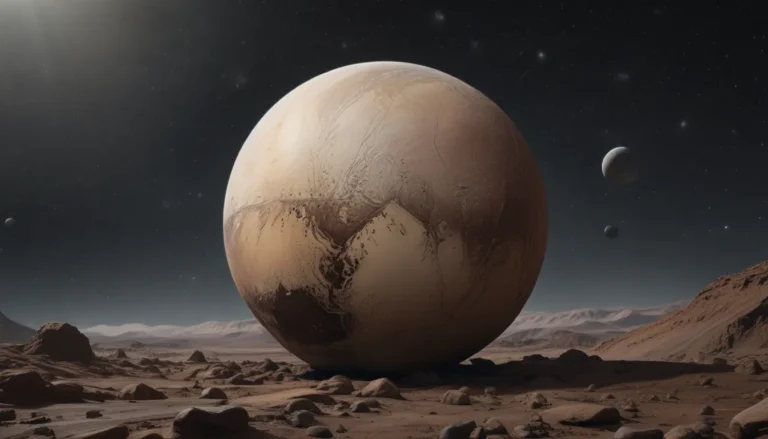The pictures we use in our articles might not show exactly what the words say. We choose these pictures to make you interested in reading more. The pictures work together with the words but don’t take their place. The words still tell you the important facts.
Welcome to the captivating realm of the Kuiper Belt, a vast region beyond Neptune brimming with icy wonders and celestial mysteries. Named after the visionary astronomer Gerard Kuiper, this cosmic neighborhood has intrigued scientists and enthusiasts alike with its enigmatic allure. Join us on a journey as we unravel eight astounding facts about the Kuiper Belt, shedding light on its secrets and offering a glimpse into the depths of our solar system.
Key Takeaways:
- The Kuiper Belt, home to ancient icy remnants and dwarf planets like Pluto, provides valuable insights into the formation and evolution of our solar system. - Exploring this region aids in unlocking the mysteries of the outer solar system, potentially leading to the discovery of hidden planets and unveiling cosmic origins.
The Kuiper Belt: A Vast Region Beyond Neptune
Stretching beyond the orbit of Neptune, the Kuiper Belt occupies a space from about 30 to 50 astronomical units (AU) from the Sun. Named after Gerard Kuiper, this dynamic expanse is a haven for a diverse array of icy bodies, ranging from dwarf planets to asteroids and comets.
A Relic of the Early Solar System
As a treasure trove of ancient cosmic remnants, the Kuiper Belt offers valuable insights into the early stages of our solar system's formation and evolution. These icy objects, preserved for billions of years, provide a snapshot of the cosmic processes that shaped our celestial neighborhood.
Pluto: The Iconic Resident
Discover, former ninth planet, now classified as a dwarf planet in 2006, Pluto is one of the most renowned inhabitants of the Kuiper Belt. Its presence in this region has revolutionized our understanding of the outer solar system, opening new chapters in astronomical exploration.
Exotic and Diverse Objects
From the icy dwarf planets like Pluto to unique celestial entities such as Haumea and Makemake, the Kuiper Belt boasts a rich tapestry of objects, each holding clues about the early solar system's composition and dynamics.
Source of Enigmatic Comets
The gravitational interactions within the Kuiper Belt play a crucial role in destabilizing the orbits of icy bodies, potentially sending them hurtling towards the inner solar system as dazzling comets. These celestial nomads offer a glimpse into the dynamic nature of our cosmic neighborhood.
Insights from the New Horizons Mission
In a historic feat, NASA's New Horizons spacecraft conducted a flyby of Pluto in 2015, providing a wealth of data and imagery that not only enriched our understanding of Pluto but also offered unprecedented insights into the enigmatic realm of the Kuiper Belt.
Unraveling the Enigma of Planet X
The Kuiper Belt's gravitational influences hint at the existence of an undiscovered ninth planet, often referred to as Planet X. The ongoing exploration of this region holds the promise of unveiling this elusive world and expanding our knowledge of the outer reaches of our solar system.
Illuminating the Mysteries of the Outer Solar System
By delving into the objects within the Kuiper Belt, scientists can glean valuable information about the outer solar system's evolution and dynamics. This endeavor not only sheds light on our solar system's origins but also offers insights into planetary formation and cosmic processes.
Conclusion
The Kuiper Belt stands as a testament to the grandeur and complexity of our solar system, harboring secrets that beckon us to explore and unravel. With each discovery and revelation, we inch closer to understanding the cosmic ballet that shaped our corner of the universe. The Kuiper Belt is not just a region of icy bodies but a gateway to a deeper comprehension of celestial phenomena that transcend boundaries of space and time.
FAQs
- What is the Kuiper Belt?
-
The Kuiper Belt is a region beyond Neptune populated by small, icy objects that offer insights into the early formation of the solar system.
-
How was the Kuiper Belt discovered?
-
Astronomer Gerard Kuiper first proposed the existence of the Kuiper Belt in 1951, with subsequent observations confirming its presence in the 1990s.
-
Are there known dwarf planets in the Kuiper Belt?
-
Yes, Pluto, Eris, Haumea, Makemake, and Ceres are among the known dwarf planets residing in the Kuiper Belt.
-
Are there missions planned to explore the Kuiper Belt?
-
While there are currently no specific missions focused solely on the Kuiper Belt, the New Horizons mission has provided valuable insights into this region, paving the way for future exploratory endeavors.
-
What other celestial bodies inhabit the Kuiper Belt?
- Apart from dwarf planets, the Kuiper Belt hosts an array of small objects, including asteroids, comets, and trans-Neptunian bodies, offering a diverse canvas for scientific exploration.
Embark on a journey of discovery into the Kuiper Belt, where ancient mysteries meet modern exploration, unveiling the splendor and complexity of our cosmic neighborhood. Let the wonders of this icy realm spark your curiosity and ignite a passion for unraveling the secrets of the universe. As we peer into the depths of the Kuiper Belt, we glimpse the vastness of existence and the timeless dance of celestial bodies that shape our cosmic tapestry.






